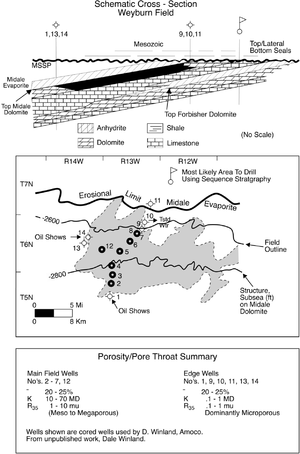Diagenetic traps: criteria for recognition
| Exploring for Oil and Gas Traps | |

| |
| Series | Treatise in Petroleum Geology |
|---|---|
| Part | Predicting the occurrence of oil and gas traps |
| Chapter | Exploring for stratigraphic traps |
| Author | John C. Dolson, Mike S. Bahorich, Rick C. Tobin, Edward A. Beaumont, Louis J. Terlikoski, Michael L. Hendricks |
| Link | Web page |
| Store | AAPG Store |
It is important early on in a play to consider if diagenetic changes play a major role in trap modification. Test, production, geochemical, and show data provide the best criteria to recognize diagenetic modifications.
General geologic indications[edit]
Diagenetic traps can exist in the company of the following geologic indicators:
- Geologic setting conducive to development of paleotopographic relief
- Unconformities present
- No relationship between present-day depth and hydrocarbon production for a given zone
- Hydrocarbon accumulations in the absence of structural closure and not following closures created by primary facies changes
Petrographic indicators[edit]
Following are petrographic indicators of the potential presence of diagenetic traps:
- Early, pervasive, prehydrocarbon cements present updip from known production within a given facies (updip seal vs. downdip reservoir)
- Late, deep-burial cements or fabrics present, such as saddle] or nonplanar dolomite, ferroan poikilotopic calcite, and anhydrite
- Abrupt vertical change in the amount of deep-burial cements present but not coincident with a change in depositional fabric (paleo oil–water contacts)
- Secondary porosity present but not related to subaerial exposure (subsurface deep burial dissolution)
- Zones of secondary porosity interbedded with tight rock in a depositionally homogeneous facies
Production indicators[edit]
The following indicate from field production the presence of diagenetic traps.
- Field boundaries within a given formation not coincident with structural closure or facies boundaries
- Tilted oil–water contacts present
- Adjacent structures not in pressure communication
- Pressures in oil-charged reservoirs unusually high
- Most of the wells characterized by high initial potential followed by rapid, sharp decline in flow rates; water cut typically low
Example: diagenetic trap[edit]
Weyburn field, Alberta, is an example of a giant diagenetic trap (1 billion BOE). Primary trap geometries appear to be along the updip termination of the Midale dolomite above the potential bottom seal of the Frobisher anhydrite and beneath the top seal of the Mesozoic section. If only these trapping geometries were used to locate the trap, sequence stratigraphic mapping initially would not have located the trap. However, microporous dolomites are present near the Mesozoic sequence boundary in the updip portion of the Midale dolomite. These mesoporous dolomites downdip form the reservoir facies.
The microporous strata form the lateral seal. The sinuous updip edge is a large waste zone that contains live oil shows in microporous strata, indicating the accumulation is downdip.
Figure 1 contains a cross section, map, and summary of the field.
